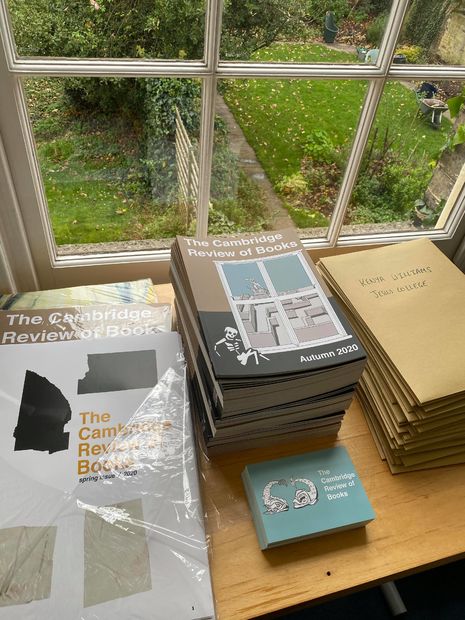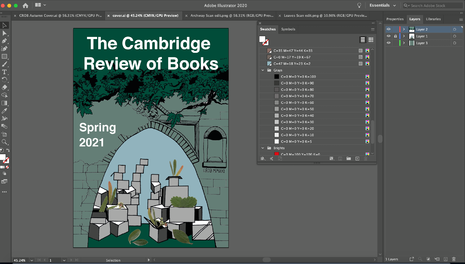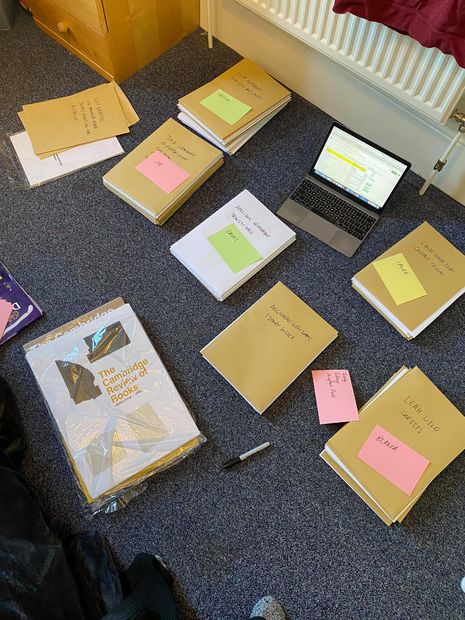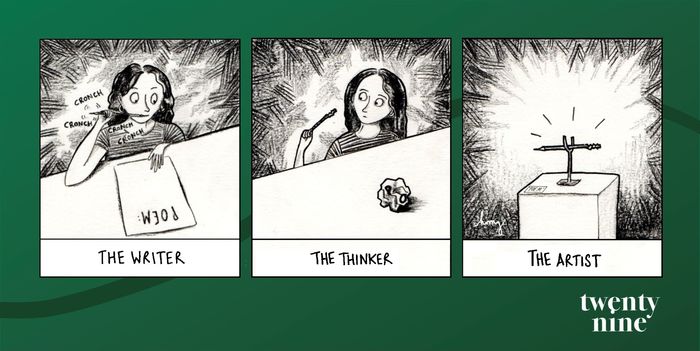Behind the Zines: Finding a home at the Cambridge Review of Books
CRoB’s Head of Editorial Rachel Imrie details the exciting and delightfully peculiar process of preparing for the spring issue of one of Cambridge’s most recent and rising zines.

‘Who gives a f**k about the Oxford comma?’ ask Vampire Weekend. 'Well,' I muse to myself as I begin the first round of copyediting for the Spring Issue of the Cambridge Review of Books, 'I very much do'. I care rather a lot about the Oxford comma, the relative merits of an em-dash over an en-dash, and, having spent a long while on the phone discussing the subject, whether punctuation ought to come before or after speech marks. Such is the glamour of publishing a magazine.
The Cambridge Review of Books was established in early 2020 by three friends: Ben, Ben, and Grace. When I first saw it come across my Facebook timeline, I was intrigued but also intimidated. Despite its ingenue status on the Cambridge zine scene, the Review’s branding already seemed so polished; their vision was so coherent, promising to be a new space for critical writing with a strong focus on editorial, bespoke illustration, and print.
As I took up the role of Head of Editorial of the magazine last summer, I feared that I would be unable to maintain the high standard set by the original team because I lived in wilful ignorance of the University’s arts scene for my first two years at Cambridge. Despite having loved all things arty at school, I found myself to be unpractised and inarticulate when discussing these ideas with my peers at Cambridge. I quickly became dogged by the sense that while I loved books and was known to enjoy the occasional Guardian culture piece, that scene just wasn’t for me. It was for the proper, talented arts crowd. Your Zadie Smiths and the like, who wore wide leg trousers and discussed big ideas over an evening glass of sherry.

However, what I love about editing is that it’s actually quite a technical process: moving commas, requesting clarity where it is lacking, and restructuring paragraphs or sentences all in pursuit of reinforcing a larger argument. Editing can sometimes be imagined in rather romantic terms: it ekes out the artistry in the writer’s words, etc. While there is a bit of that, a lot of the time that creativity is already there in the first draft. Some truly excellent writing has been featured in past issues of CRoB, and this term, our publishing team has worked hard to make some of these pieces available to read on our website. You need only browse there for a few minutes to observe the range and depth of talent that the Cambridge Review of Books has had the pleasure of publishing.
We have always aimed to choose pieces that will suit a variety of tastes. There is a reason why I always ask prospective members of the editorial team what they like to read, because while the writing included in the magazine should always be of a high quality, it shouldn’t be homogeneous in either its content or its style. Our pieces range from the introspective and moving, like Maddy Pulman-Jones’s lyrical essay on Joni Mitchell and Emily Dickinson, to the carefully analytical, like Joe Turrell’s consideration of ‘Slow Cinema’. It was also important to me that the magazine maintain a sense of humour and a playfulness, hence why Juliette Odolant’s poem ‘Mrs Dalloway’s Best Nightmare’ from the Autumn Issue is a particular favourite of mine.
“Our readers have told us that they treasure the magazine as a physical object”
Another feature which makes the Cambridge Review of Books such an exciting publication to work on is its commitment to print. Our readers have told us that they treasure the magazine as a physical object, published on high quality paper and with a tailored illustration accompanying every piece. None of this would be possible without Sorcha and Marion, the Review’s Head of Publishing and Head of Design respectively. Whilst at other zines these roles are sometimes fulfilled by editors, at CRoB we think having separate teams for Editorial, Publishing, and Design both balances the workload and allows us to give each aspect the dedication it deserves.

For those interested in the business and management side of the magazine, the Publishing department offers a rare opportunity to gain some experience. I remain in constant awe of the work Sorcha has done to develop the brand and profile of the Review this year, not to mention all the time she spends keeping the team organised! Marion, meanwhile, not only co-ordinates our team of illustrators, but is the creative brain behind the beautiful covers and layout of our Autumn and Spring Issues.
As the original team handed over responsibility to me, Sorcha, and Marion, I tried to articulate my vision for the magazine to Ben, one of the founding editors. I told him that I wanted to capture that moment when you find yourself in conversation with a friend of a friend at the pub, and you end up chatting about that one thing that they’re really passionate about. You may have heard of it, you may not have, but you get them just tipsy enough to talk about it exuberantly and unironically, and you realise that because they care, you care too. Something like that — but with some semi-colons thrown in.
“Contained within its pages is a babble of voices”
The Spring Issue of the Cambridge Review of Books, like those which have preceded it, showcases the writing and art of many talented students. Contained within its pages is a babble of voices. Someone in the corner is retelling their grandparents’ love story through the novel that brought them together; others are sharing the poems and stories they wrote about community and family, and there are folks discussing Soviet art and John Lennon’s short fiction, considering clutter, nature, and much, much more — and we can’t wait to share it with you.
The Spring Issue of the Cambridge Review of Books is available to pre-order now for £3.75 from: www.the-crob.org
 News / Eight Cambridge researchers awarded €17m in ERC research grants27 December 2025
News / Eight Cambridge researchers awarded €17m in ERC research grants27 December 2025 News / Clare Hall spent over £500k opposing busway 24 December 2025
News / Clare Hall spent over £500k opposing busway 24 December 2025 Comment / League tables do more harm than good26 December 2025
Comment / League tables do more harm than good26 December 2025 Comment / The ‘class’ of Cambridge24 December 2025
Comment / The ‘class’ of Cambridge24 December 2025 News / Caius mourns its tree-mendous loss23 December 2025
News / Caius mourns its tree-mendous loss23 December 2025









